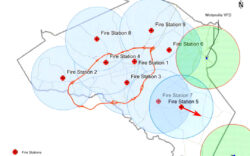Athens is projected to add 30,000 residents by 2045—maybe more, depending on how much UGA enrollment grows. Athens-Clarke County officials are currently in the process of deciding where to put all those people as they move toward adopting a new land-use map for the first time in more than 20 years.
“We’re not a small college town anymore,” Bruce Lonnee, assistant director of the ACC Planning Department, told county commissioners at a Jan. 9 work session. “We’re a mid-size city.”
Commissioners got their first look at a draft of the new growth concept map at the work session. Downtown and Georgia Square Mall—which will be redeveloped for mixed use in the coming years—are designated for the highest density. The map focuses on growth at “nodes” at major intersections, creating a dozen mini-towns within the city. But all neighborhoods with sewer service can expect some incremental growth, with the “green belt” of agricultural land on the northern and eastern edges of the county continuing to be protected.
“They [residents] want to see growth, but they want that growth to go to targeted areas, and they want a certain type,” planner Marc Beechuk said.
The object is to bring residents closer to jobs and services, reducing the need for crosstown trips. Planners said that’s something that came up frequently in their interactions with residents. The department received more than 2,000 comments from several hundred individuals at 26 events to gather feedback on the growth concept map.
Other frequent comments included “senior housing, more housing, affordability over and over again,” Beechuk said. Protecting greenspace was also important to residents. “It wasn’t just trees, it was trees, trees, trees—trees everywhere, as many as we can get,” he said.
Since population growth is inevitable, to avoid sprawl, Athens will have to grow upward. That will mean more density—redeveloping aging low-slung apartment complexes into taller ones, for example, or allowing duplexes and townhouses in single-family zones. The details will be hashed out later, once the commission adopts the land-use map this summer, and planners move on into amending the zoning code to match the map.
But one exchange between commissioners Melissa Link and Allison Wright illustrated why adding density might be difficult politically. While residents may want it generally, it’s rarely a popular idea in one’s own neighborhood.
Link complained that all of the UGA-related growth is happening downtown, in her district, and suggested that it should be funneled to other UGA-adjacent areas with less density, like Five Points. “I really think we should focus some more student-oriented growth on that side of town,” Link said.
Wright, who represents part of Five Points, objected. Five Points already has its fair share of multifamily properties, she said. “I think we can spread that university densifying in more places than just around the university,” Wright said.
Density in appropriate areas will create a more vibrant city, with more support for locally owned small businesses and restaurants, Mayor Kelly Girtz said. That density should be focused on areas that already have the infrastructure, but Girtz said he is open to expanding sewer in the Sandy Creek basin—something past commissions long resisted because of the potential environmental impact of sewer spills. But the neighborhoods around Sandy Creek are full of homes with failing septic systems, also an environmental hazard. Some sort of septic tank utility could be another option if the commission opts not to encourage development in the basin, as sewers are expensive and generally not cost-effective for low-density areas.
The Trail Creek area, near Space Kroger on Highway 29, already has the infrastructure and room to grow. (In Athens’ gravity-driven system, sewer mains are usually named for the creeks and rivers they run alongside.) Another spot planners want to look at is the old reservoir off Highway 441 near the Loop, the site of a failed amphitheater development. County officials are also cognizant of the need to protect gentrifying East Athens from spillover development in the downtown “river district,” where the new Classic Center arena is sure to spur growth.
Commissioners also heard an update on a Keep Athens-Clarke County Beautiful surveillance program to stop illegal dumping. After the commission funded the program in 2021, 27 cameras were placed at eight frequent dumping sites and have caught 97 violations. Police issued warning letters or $300 fines to those caught on tape.
And the commission learned about the process for collective bargaining negotiations with ACC firefighters’ new union. The commission agreed to allow the fire department to unionize last June, and in December local firefighters voted to join the International Association of Firefighters. Under a Jimmy Carter-era state law, firefighters are the only government employees who are allowed to collectively bargain.
Like what you just read? Support Flagpole by making a donation today. Every dollar you give helps fund our ongoing mission to provide Athens with quality, independent journalism.










